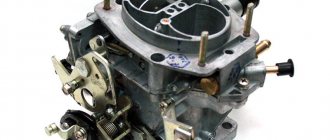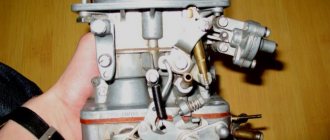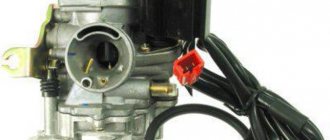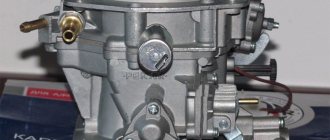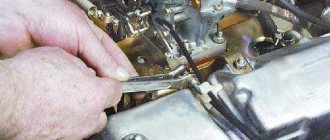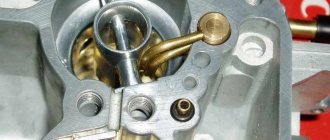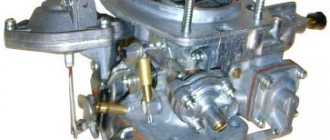The carburetor on any vehicle is one of the components of the fuel system of an internal combustion engine. It mixes air with fuel liquid, and this mixture is supplied to the cylinders of the internal combustion engine. As you can see, this automotive part plays a very important role in the functioning of the vehicle as a whole. Therefore, the carburetor must be adjusted periodically. You will learn how to do this correctly on a VAZ-2105 from this article.
The first stage is setting up the float mechanism of the VAZ-2105 carburetor
First of all, to adjust the carburetor float mechanism, the car should be allowed to idle. And only after that begin the adjustment procedure.
- The carburetor cover is removed.
- The current level of fuel fluid in the chamber of the float mechanism is checked (its digital indicator should ideally be 28 mm).
If the digital indicator of the fuel level in the float chamber corresponds to the norm, then nothing needs to be adjusted. Otherwise, you need to do the following:
- check the distance from the cover gasket and the float itself (this is done at the moment the needle valve ball comes into contact with it) - the norm is 6.5 mm (+- 0.25 mm);
- bend the tongue;
- check the maximum stroke of the valve needle - the norm is 8 mm;
- check the distance from the cover gasket to the maximum retracted float - the norm is 14 mm (+- 0.5 mm).
If the indicators do not meet standard standards, they can be adjusted using a bracket. If the optimal level of fuel fluid in the float chamber was not obtained after adjustment, the needle valve will have to be replaced.
Jets
For some reason, the instructions categorically do not recommend increasing the jets, but the risk is justified and in some cases the improvements are obvious. Of course, it is dangerous to immediately change all existing combinations at once, so changes should be made gradually.
So, the primary camera:
- GTZh (main fuel jet) - 125.
- GVZh (main air jet) - 150.
We leave the secondary camera as is and check it. Acceleration will be better.
Let's move on to the second chamber:
- GTZ - 162.
- GVZh - 190.
The result of the changes will be a feeling as if the gas pedal is pressed until the secondary chamber opens and the turbo is turned on, while the engine easily spins up to 6000–6500 rpm. Fuel consumption may increase slightly. This is due to the fact that, when moving around the city, you will not accelerate strongly at traffic lights every time, so you will be able to save gasoline only on the highway or in the case of empty city roads.
If you approach tuning your original five wisely, you can refine it to excellent condition. The car will serve you for many more years and will delight you with its improved characteristics.
Sources
- remam.ru/tune/tyuning-karbyuratora-vaz-2105.html
- ladaautos.ru/vaz-2105/kak-delaetsya-regulirovka-karbyuratora-vaz-2105.html
- carnovato.ru/karbjurator-zhiklery-vaz-2105/
- drive2.ru/b/2232459/
- swapmotor.ru/ustrojstvo-dvigatelya/karbyurator-vaz-2105.html
- bumper.guru/klassicheskie-modeli-vaz/toplivnaya-sistema/karbyurator-vaz-2105.html
The second stage - we adjust the starting device of the VAZ-2105 carburetor
At this stage, in a garage environment, a car enthusiast can perform the following steps to configure the carburetor system that starts and warms up the engine:
- close the air damper (this is done using the thrust handle located in the car interior);
- check the location of the rod shank, which must be at the end of the groove of the carburetor rod to start the system;
- measure the gap level from the edge of the valve to the chamber wall (measurements are taken when the rod is recessed) - the norm is 5-5.5 mm.
If the digital indicators differ from the established standards, they are adjusted by rotating a special adjusting screw (it is located on the carburetor trigger).
Fuel mixture quality adjustment screw Solex 21083
Why do you need a Solex 21083 carburetor quality screw?
The quality screw is necessary to change the composition of the fuel mixture entering the car engine at idle (idle). By turning the screw we lean the fuel mixture, by turning it away we enrich it. In this way, you can adjust the air/gasoline ratio to ensure it operates at a minimum stable idle speed.
Where is the quality screw installed on the Solex 21083 carburetor?
The fuel mixture quality adjustment screw is installed in the lower part of the carburetor body, at the outlet of the emulsion channel. The screw is screwed into a special channel at the bottom of the carburetor body. It changes the flow area of the outlet.
The outlet of the CXX Solex 21083 through which the fuel mixture is sprayed, the composition of which is regulated by a quality screw.
How does a Solex 21083 quality screw work?
The Solex 21083 carburetor quality screw is a metal screw of a certain shape with a thread. A rubber O-ring is installed on it to prevent excess air from entering the CXX channel. One end of the screw has the shape of a needle; the other has a cut for a 3 mm slotted screwdriver. See photo at the beginning of the article.
How does the fuel mixture quality adjustment screw work?
The easiest way to see how the quality screw works is in the Solex 21083 CXX diagram.
Under the number “14” is the quality screw.
A mixture of air and gasoline (fuel emulsion) is formed at the CXX fuel nozzle, where gasoline entering the carburetor CXX from the float chamber and air from the air duct are mixed. Under the influence of vacuum at the edge of the throttle valve of the first chamber, it is pulled through the emulsion channel and the CXX outlet into the engine intake manifold. The engine runs on this fuel mixture.
If we tighten the quality screw all the way, we will completely block the outlet of the emulsion channel of the idle system. Fuel stops flowing into the engine and it stalls.
If you turn the quality screw out a little, fuel will begin to flow into the engine and it will idle.
In order for the car engine to operate stably at idle, you should unscrew the quality screw at least half a turn from the stop and adjust the idle speed with setting the position of the fuel mixture quantity screw. It is necessary to achieve such a mutual position of these two screws that the idle speed is 650-700 rpm and the CO content in the exhaust gases is within normal limits.
Malfunction of the fuel mixture quality screw
There are only two malfunctions: clogging of the idle air system outlet and damage to the rubber O-ring on the screw.
Over time, the idle air system outlet becomes clogged with deposits and soot from the engine intake manifold. The quality screw needle ceases to play the role of a locking device, since the hole is already clogged. Depending on the degree of contamination, the engine begins to idle unsteadily or the idle speed disappears altogether. When turning the quality screw when adjusting the XX speed, the reaction will be weak or not at all.
You can quickly clean the outlet, quality screw and emulsion channel yourself without disassembling the carburetor using a cleaning aerosol. Details about the cleaning procedure: “Cleaning the idle system of the Solex carburetor 2108, 21081, 21083.”
The channel where the quality screw is installed leads directly to the CXX emulsion channel and its outlet. Therefore, this is one of the places where foreign air is likely to “suck” into the carburetor. Foreign air depletes the fuel mixture, as a result of which the engine does not have enough energy to rotate the crankshaft at idle, and it begins to “triple” and tries to stall. The reason for the air leak is a worn rubber o-ring on the quality screw. It may fail due to age or careless repairs.
Replacing the ring with a new one will help correct the problem of air “sucking” into the carburetor and restore normal idle speed of the car engine.
Notes and additions
If, with the quality screw fully tightened, the car engine does not stall, but continues to run, you should look for places where fuel is likely to enter the engine in addition to the carburetor idle system
Or pay attention to the position of the throttle valve of the first chamber. Perhaps it is very slightly open and in addition to the outlet hole of the CXX, underneath it there is an exit slot of the transition system of the first chamber and the fuel is drawn out of it by vacuum
The position of the throttle valve is regulated by the quantity screw, which with its tip rests on the lever on its axis.
Third stage - idle speed adjustment
This stage is no less important than the previous two. To do this, the internal combustion engine is pre-started and warmed up. Only after this can the idle speed be adjusted.
- The motor is brought out using rotational movements of the mixture quantity screw - the norm is 850 rpm:
- to increase the speed, you need to rotate the mixture quality screw (to the maximum level);
- to reduce the speed you need to rotate the quantity screw (to the desired level of 850).
- Tighten the quality screw as far as it will go (rotational movements are performed until the motor stops shaking).
- Unscrew the same screw in the opposite direction three turns.
In this way, the VAZ-2105 carburetor is adjusted at idle. Auto mechanics call all of the above actions calibration of the crankshaft idle speed.
Functions
The functionality of the element in question is quite simple. It is designed to enrich the incoming fuel mixture with oxygen and then remove it into the combustion chamber.
This whole process can be described by the term mixture formation. Its first stage is to introduce gasoline into the air stream, atomize it and partially evaporate it. Next, the mixture enters the intake manifold and cylinders, without ceasing to evaporate. The next stage is fuel dosing. After this, adjusting to the engine operating mode, the amount of mixture changes.
Expert advice
After completing the procedure for adjusting the VAZ-2105 carburetor device, experienced auto mechanics recommend paying attention to the following critical points:
- Valve location - is in the retracted position, with the idle speed jet touching the seat in the carburetor body.
- Lubricating the rubber seal with special motor oil.
- The location of the air damper intended for cold passage is in a vertical plane, while the suction handle is lowered.
- The condition of the solenoid valve - the presence of damage and malfunctions is checked as follows:
- turn on the ignition;
- remove and put the connector on the valve;
- listen to the sounds coming from the solenoid valve.
If clicks are heard during the inspection process, the part is in full working order.
Transitional system, GDS
When the driver presses the gas pedal, the throttle valve opens slightly. The engine receives fuel due to vacuum through the small diffuser of the first chamber and the jets of the main metering system. At the same time, the GDS is not yet fully operational, but the idle system is still working.
If you press the gas sharply, the accelerator pump will start. It injects a portion of gasoline through its spout directly into the manifold. The pump is designed to eliminate failures when starting and accelerating the car.
A further increase in speed entails an increase in vacuum. The force begins to retract the membrane, and it opens the draft of the secondary chamber. The diffuser and jets of the second chamber come into operation.
To prevent failures when the second chamber is fully opened, the DAAZ-2105 1107010 carburetor is equipped with a transition system. It is designed similarly to the idle system. But the hole for supplying the combustible mixture is located higher than the closed throttle of the second chamber.
Common causes of floating revolutions
So, we figured out the main symptoms. Now let's move on to the reasons. Let us immediately note that floating idle speed is often a problem with injection engines. The fact is that a complex ECM system is responsible for idling in this case.
This system assumes the presence of a controller, sensors and actuators. The control unit receives signals from sensors and transmits commands to actuators (for example, IAC), maintaining stable engine speeds at idle and other modes, regardless of the load on the internal combustion engine.
However, any failures that are associated with the supply of air, fuel, a violation of the composition of the working fuel-air mixture or its ignition, as well as various mechanical breakdowns will lead to floating speed.
As a rule, in practice, the idle air regulator causes a lot of problems for drivers. In fact, this is a stepper motor that has a conical locking needle. When the throttle valve is closed, air bypasses the valve through a channel that is closed by the needle.
If malfunctions occur in the operation of the device, the ECU is not able to correctly “select” the mixture composition at idle, as a result, the speed floats.
The mass air flow sensor also deserves special attention. During operation, the air flow sensor may become dirty or break down.
Ozone
This sample originates from the sixth Lada model. About 30 years ago, designers stated that it would be a sales leader in domestic car markets. Such prospects were explained by its design features.
Unlike the Solex and DAAZ samples, this prototype had a vacuum drive for the damper, which is responsible for the flow of fuel into the second chamber. Its drive did not depend on the float, but was driven by a rod located on the diaphragm. Such a device was supposed to provide fuel savings.
His design had nothing special: 2 chambers (primary and secondary), four jets, 2 throttle valves, etc. But still, it occupied a leading position in the market.
In addition to the standard carburetor 2107, there was a modification “Ozone” 1107010. Its difference is that it was installed exclusively on the “Zhiguli” 2103 and 06 engines, which were installed on the Lada 2105 and 07. Since this mechanism had a vacuum damper drive, the modification 1107010, was subdivided into 1107010 - 20. The number “20” meant that this device was installed only on the latest Lada 2107 models with a “Six engine.
Modification of turbocharging (pseudo-turbocharging)
Not all car enthusiasts agree to take such a serious step. But nevertheless, this tuning of the VAZ-2105 carburetor adds good dynamics, so it can still sometimes be found on domestic cars.
So, how do you make pseudo-turbocharging? Instead of the usual hose that supplies warm air to the air filter, we install one of the same diameter, but longer in length. This is done in order to bring it directly to the fan. Air currents will directly enter the hose in a constant flow.
Now let's talk about the dangers and consequences of this tuning. Since the air is supplied directly, dirty droplets entering the hose are sent directly to the air filter. Which can delay the entry of all debris, but some of it is still sent to the cylinders. And this, over time, ensures wear of the piston group. Therefore, think carefully before upgrading your car in this way.
Throttle manipulation
First, remove the springs from the carburetor primary chamber throttle vacuum actuator. These actions will allow you to immediately feel the improvement in car dynamics while driving; fuel consumption per 100 km will increase by less than a liter.
By modifying the carburetor on the Lada 2105, you can increase power and dynamics
Refinement of the VAZ-2105 carburetor also involves replacing the vacuum drive of the secondary chamber throttle valve with a mechanical one. It's not as difficult as it seems.
To do this, take a small piece of straight wire and bend it into a ring at one end, push it under the nut that holds the throttle drive lever of the second chamber.
As a result, the protrusion of the outer chamber arm should be between the wire and the second drive arm. Tighten the nut firmly.
These simple tuning steps for the VAZ-2105 carburetor will improve dynamics, while fuel consumption will remain the same.
Removal and installation of TPS
The first step is to disconnect the minus terminal from the battery, and then disconnect the chip with the power wires from the sensor, as shown in the photo below:
Now, using a Phillips screwdriver, unscrew the two screws securing the sensor to the throttle assembly.
After both screws are unscrewed, carefully move it to the side.
The seat has a special foam pad that needs to be kept intact. The new sensor is installed in the reverse order, so that the holes in it coincide with the holes in the throttle.
The price of a new TPS for injection VAZ 2104, 2105 and 2107 is about 200-500 rubles. The cost depends on the manufacturer and place of purchase.
Source
DAAZ
Second place, after Ozon, was occupied by DAAZ. This VAZ 2107 carburetor, unlike its “colleagues,” had an economizer device that provided forced idling. This difference did not have a significant impact and did not make this mechanism special.
Since “DAAZ” is a modification of “Ozone”, it also has options with the index 1107010 and 1107010 - 20. It is impossible to immediately say which carburetor is better to install on the Lada 2107. To do this, you need to decide what exactly you want to get from this device.
Disassembling, cleaning and assembling the VAZ 2107 “DAAZ” carburetor is one of the simplest tasks compared to cleaning other models. Although the layout of the unit is no different from the others, its design was somewhat simpler.

